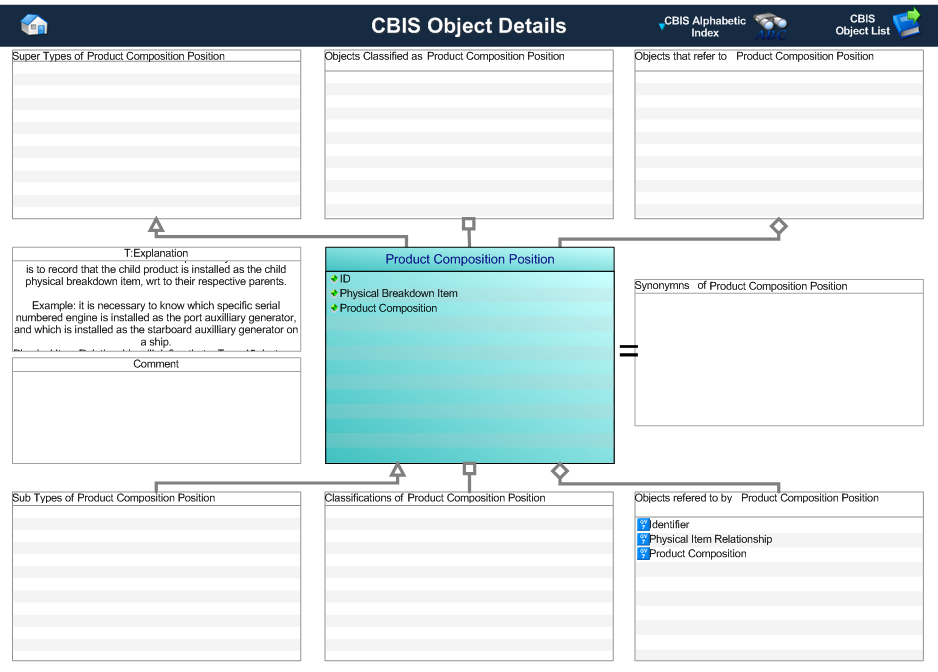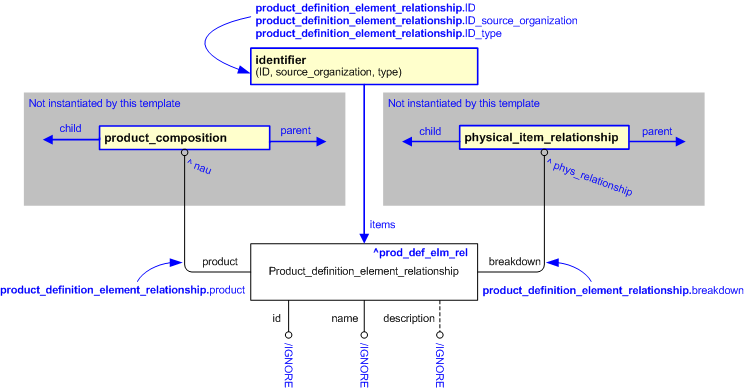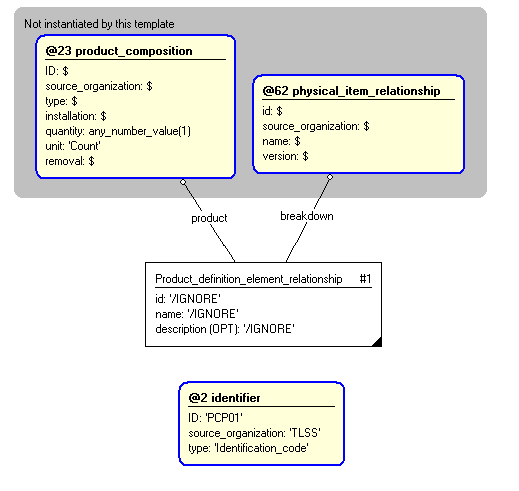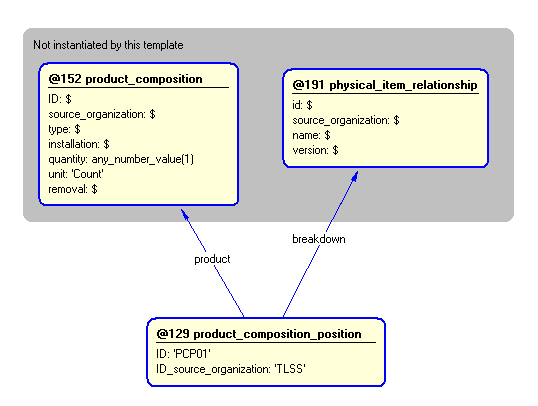Template:— product_composition_position (prod_comp_pos)
Context:— UK_Defence |
Date: 2010/07/16 11:51:36
Revision: 1.5
|
This section specifies the template product_composition_position.
NOTE
The template has been defined in the context of
UK_Defence.
Refer to the business context for details of related templates.
NOTE
An explanation of a template and the associated instantiation path is
provided in the
Template overview
section.
This template describes how to represent the relationship between a parent / child relationship between two products and a
parent / child relationship between two physical breakdown items.
It uses Product_definition_element_relationship.
This Information Object represents the relationship of the parent / child relationship between two products and the parent
/ child relationship between two physical breakdown items.
This is used to establish which position an actual product is installed in if there is more than one possibility.
The intention is to record that the child product is installed as the child physical breakdown item, wrt to their
respective parents.
EXAMPLE
It is necessary to know which specific serial numbered engine is installed as the port auxilliary generator, and which
is installed as the starboard auxilliary generator on a ship.
Physical Item Relationship will define that a Type 45 destoyer can have port and starboard auxilliary generators.
Product Composition will define that Cummins diesel engine serial numbers 123 and 456 are installed in HMS Daring.
Product Compsition Position will define which serial numbered engine is installed as the port and which is installed
as the starboard auxilliary generator.
Figure 1 — Graphical Representation for Business Object Product Composition Postion
|
Attribute name
|
Attribute description
|
Attribute type
|
Optionality
|
| ID |
This is the identifier of the product composition position. |
Identifier |
Mandatory |
| Physical Breakdown Item |
This is the reference to the physical item relationship that defines the position of the child with respect to its parent
in the related product composition relationship.
|
Physical Item Relationship |
Mandatory |
| Product Composition |
This is the reference to the parent / child product relationship whose position is defined by the related physical item relationship. |
Product Composition |
Mandatory |
Table 1 — Product attribute details
The EXPRESS-G diagram in
Figure
2
shows the templates and EXPRESS entities that are required
to represent the template
"product_composition_position".
The text highlighted in blue shows the template parameters.
Figure 2 — An EXPRESS-G representation of the Information model for product_composition_position
The graphic for the template to be used in other EXPRESS-G diagrams
is shown in Figure
3
below.
Figure 3 — The graphical representation of the product_composition_position template
The following input parameters are defined for this template:
The identifier of the product definition element relationship.
The identifier of the product definition element relationship.
This is the reference to the product composition.
This is the reference to the physical item relationship.
The following reference parameters are defined for this template:
%^target = $product_composition_position.prod_def_elm_rel%
The following parameter combinations specify a uniqueness constraint:
Unique constraint: Unique id
The instantiation path shown below specifies the entities that are to be
instantiated by the template.
A description of templates and the syntax for the instantiation path is
provided in the
Templates Help/Information section.
The following entities are instantiated with attributes as specified:
The instance diagram in Figure
4
shows an example of the EXPRESS entities and templates that are instantiated by the template:
/product_composition_position(items='#1', class_name='Safety_critical', ecl_id='urn:plcs:rdl:std')/
(an illustration of the consolidated product_composition_position template is shown in
Figure
5 below.)
Figure 4 — Entities instantiated by product_composition_position template
The instance model in STEP ASCII exchange file format (ISO 10303 Part
21 syntax) is:
#1 = TASK_METHOD($,$,$,$,());
#2 = EXTERNAL_CLASS('/IGNORE','Safety_critical',$,#3);
#3 = EXTERNAL_CLASS_LIBRARY('urn:plcs:rdl:std',$);
#4 = CLASSIFICATION_ASSIGNMENT(#2,(#1),'/IGNORE');
The instance model in STEP XML exchange file format (ISO 10303 Part
28 ed.2 syntax) is:
The instance diagram in
Figure
5
shows the graphic symbol for the template that is to be
used in other instance diagrams. The example template is:
/product_composition_position(items='#1', class_name='Safety_critical', ecl_id='urn:plcs:rdl:std')/
Figure 5 — Instantiation of product_composition_position template
Characterizations
No common characterizations of the template
product_composition_position
have been identified. However, the ISO 10303-239 EXPRESS model
may enable other assignments to the entities instantiated by the template.




